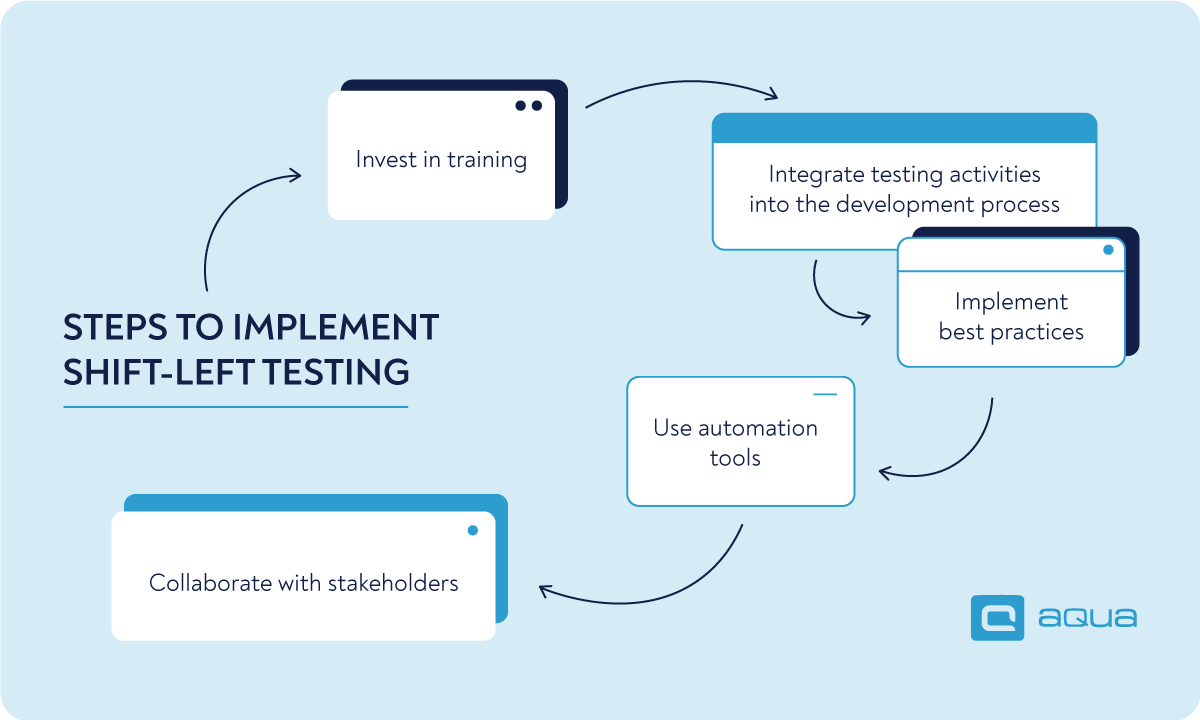What is shift-left testing?
Shift-left testing is an approach that moves testing activities earlier in the software development lifecycle. Unlike traditional testing methods, it involves integrating testing processes with development rather than performing them towards the end. This way, you can identify bugs and defects earlier in the process and reduce the risk of them appearing later in the software development lifecycle.
"Test early and often."
The main goal of shift-left testing is to improve software quality while reducing the time and costs of fixing bugs. It is a significant part of DevOps practices and contributes to a culture of collaboration and continuous improvement.
We’ve discussed DevOps more extensively in our latest video, it could be useful for your learning.
Why is it called a shift to the left?
So why do we call it shift-left testing? In traditional software development models, testing typically occurs towards the end of the development process, often called the “right” side of the development timeline. However, with the rise of Agile and DevOps methodologies, there has been a shift in approach where testing is moved earlier in the development process. Hence, the term “shift to the left.”
This means that you perform testing activities, like unit testing, integration testing, and automated testing, earlier in the development lifecycle, closer to the initial stages of coding and development. Shift-left basic principles aim to identify and address defects and issues earlier in the development process, leading to faster feedback loops, reduced costs, and improved software quality.
“Shift left to me is more QA and Dev working together on the ticket… Once the Dev is done (or maybe during) and before it is merged they both review the changes and any tests the Dev has done and can give input as to whether the testing was sufficient.”
What are the benefits of shift-left testing?
So why do developers recommend shift-left testing principles? Here are some significant benefits of implementing it:
- Early defect detection and resolution help reduce the costs of fixing issues later in the software development cycle.
- Improved collaboration and communication between development and testing teams with a better understanding of requirements.
- Faster feedback loops allow for more rapid identification and resolution of the bugs.
- Reduced time-to-market for software products as development and testing activities are completed simultaneously.
- Improved software quality due to the early identification of the bugs.
Overall, the list of shift-left testing benefits can be longer, but it depends on how well it is implemented. If done right, it can also improve developer & QA efficiency, productivity, and, ultimately, customer satisfaction.
How to implement shift-left testing?
There are some steps you can follow to implement the shift-left testing approach effectively:
- Invest in training to ensure both teams have the necessary skills to implement the shift-left methodology.
- Integrate testing activities into the development process to perform them concurrently with the development activities.
- Implement best practices to establish testing standards, develop test cases, and perform code reviews to ensure your testing is complete.
- Use automation tools to speed up testing activities, increase efficiency, and reduce the risk of human error.
- Collaborate with stakeholders, such as business analysts, developers, and testers, to ensure everyone is on the same page and that testing is aligned with business goals.

If you want to implement shift-left testing in your software development process, aqua cloud offers a powerful test management solution that can help. With aqua cloud, you can manage test cases, execute automated tests, and track defects in one easy-to-use platform. This QA testing tool integrates with your existing DevOps tools, so you can seamlessly incorporate testing activities into your software development lifecycle.
Get the perfect tool to reap shift-left testing benefits
Shift-left and test automation in DevOps
In DevOps practices, both shift-left and test automation are pivotal strategies to enhance software development processes and ensure high-quality software delivery. We have discussed the shift left testing strategy’s aim in the previous paragraphs. Similarly, test automation complements this approach by providing the means to execute tests rapidly and efficiently. Automated tests, including unit tests and integration tests, enable you to obtain immediate feedback on code changes, allowing you to detect bugs and vulnerabilities earlier.
Furthermore, both shift-left and test automation accelerate feedback loops within the DevOps cycle. By detecting issues early and automating testing processes, you can iterate more quickly and confidently and deliver updates to production. This iterative approach fosters continuous improvement and innovation, driving the evolution of software products in alignment with user needs and market demands.
What are the disciplines of software development to apply the shift-left approach?
To apply the shift-left methodology effectively, there are some practices you should consider, including:
- Coding and code reviews: Code should be written testable, and code reviews must ensure that code is written to the appropriate standards.
- Continuous Integration: You should regularly integrate code changes into the main branch and perform automated builds and tests after each integration.
- Test automation: You should create shift-left automation testing for each function, feature or module of the software to ensure frequent and efficient testing.
- Continuous testing: You should continuously test the code throughout the software development lifecycle to ensure the software is stable at every stage.
- Collaboration and communication: It is crucial to ensure that you integrate testing with development effectively and can identify and resolve defects as early as possible to establish strong communication between testing, development, and operations teams.
Applying these principles in your software development process will make sure you implement shift-left testing smoothly and can get the maximum out of it.
What are the best practices for shift-left testing in Agile?
Here are some best practices for implementing shift-left testing in Agile:
- Test early and often: Perform testing as early as possible and regularly test throughout the process.
- Collaborate and communicate: Foster strong, open communication between teams and stakeholders to ensure everyone is on the same page.
- Automate testing: Use automation tools for testing to reduce the risk of errors, increase efficiency, and enable faster testing.
- Create test cases: Develop detailed test cases that cover all aspects of the software (functional and non-functional), and ensure that you review and update them regularly. Don’t forget about unit testing to spot and solve issues early.
- Use metrics and analytics: Identify metrics and analytics in software testing to identify trends, track progress, and make data-driven decisions.
- Integrate testing with CI/CD: Integrate testing with your CI/CD pipeline to ensure testing is performed at every process stage.
- Focus on quality: Prioritise quality throughout the software development process.
Following these best practices will help you successfully implement shift-left testing in an Agile environment and achieve efficiency and faster time-to-market for your software products.

What will you get after implementing the shift-left strategy?
If you implement the shift-left development efficiently, you will see these positive results:
- Early defect detection: If you test earlier in the software development lifecycle, you can identify and resolve the defects before they become more complex and costly. You are less likely to let defects happen in production, too.
- Faster time-to-market: Identifying and resolving defects earlier in the software development process will ensure you can release your software products quickly and confidently.
- Increased efficiency and productivity: By automating testing activities and integrating testing with development, you can work more efficiently and with greater productivity.
- Increased customer satisfaction: If you can make sure your software has the highest quality, customers will be satisfied with the performance of the product they receive. This is a major factor for increased customer loyalty and retention.
- Reduced costs: Early defect detection and improved software stability will reduce costs associated with fixing defects, delayed releases and lost revenue.
Conclusion
Implementing a shift-left testing approach in your software development process will bring numerous benefits, including early defect detection, faster time-to-market, higher customer satisfaction, reduced costs, and better team morale.
By adopting the best practices examples we provided above, you can successfully implement shift-left testing in an Agile environment and reap the rewards.
If you want to adopt these best practices in your testing, aqua’s testing strategy template is an essential tool for you. With clear requirements for every level of testing, actionable tips to improve your testing processes, and recommendations for choosing the right testing tools, this template is a comprehensive guide to ensuring that your testing is effective and efficient.

Don't settle for mediocre testing results – use aqua's template to take your testing to the next level






